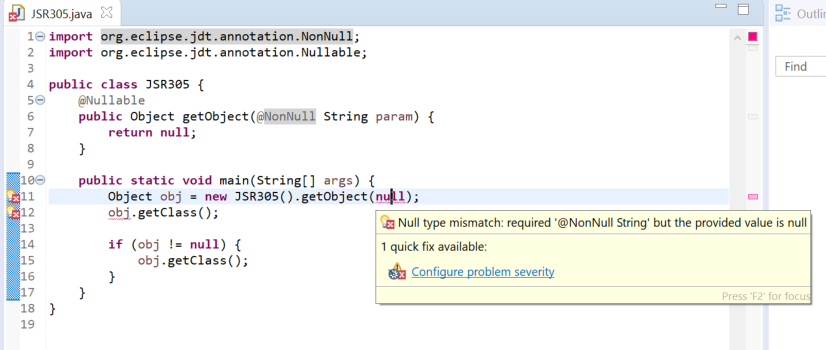What is NullPointerException (NPE)
null is a reserved value for indicating that the pointer does not refer to a valid object. In Java, access of null will trigger NullPointerException.
The history of null dates back to 1965, Tony Hoare (known for Quicksort) introduced null references in an object oriented language. In 2009 at a conference, he apologized for inventing the null reference, which he called “my billion-dollar mistake”. [1]
At that time, I was designing the first comprehensive type system for references in an object oriented language (ALGOL W). My goal was to ensure that all use of references should be absolutely safe, with checking performed automatically by the compiler. But I couldn’t resist the temptation to put in a null reference, simply because it was so easy to implement. This has led to
innumerable errors, vulnerabilities, and system crashes, which have probably caused a billion dollars of pain and damage in the last forty years.
Removing null is not possible, instead we need some mitigations. Check whether object is null before each invocation? That’s not good, as it makes code longer and harder to read.
Notice following ways are not mutually exclusive.
Mitigations
Check null in the Beginning
public void myMethod(Object object) {
if (object == null) {
throw new IllegalArgumentException("informative message here.");
}
}Comparing Known Object with Unknown Object
// Bad Case
unknownObject.equals(knownObject);
unknownString.equals("mystring");// Good Case
knownObject.equals(unknownObject);
"mystring".equals(unknownString);Use @Nullable and @NonNull/NotNull
If we can reduce the code to have potential null access in complication phase, we will have fewer NullPointerException in the runtime.
JSR 305 aims to develop standard annotations (such as @NonNull) that can be applied to Java programs to assist tools that detect software defects.
But the standard is not decided yet, we can see NonNull or NotNull in different IDEs or checkers. Take Eclipse as an example. By using proper annotation, Eclipse will show errors when it detects potential mismatch.

By default, this is not enabled in Eclipse. See Enable annotation-based null analysis in Eclipse
Optional
Java 8 introduces a new class called java.util.Optional that can alleviate some of NullPointerException problems. Following is a very good example from Tired of Null Pointer Exceptions? Consider Using Java SE 8’s Optional!
// may have NullPointerException
String version = computer.getSoundcard().getUSB().getVersion();// `Safe` version with manual null check.
String version = "UNKNOWN";
if(computer != null){
Soundcard soundcard = computer.getSoundcard();
if(soundcard != null){
USB usb = soundcard.getUSB();
if(usb != null){
version = usb.getVersion();
}
}
}// Better version with Java Optional
String version = computer.map(Computer::getSoundcard)
.map(Soundcard::getUSB)
.map(USB::getVersion)
.orElse("UNKNOWN");Avoid Returning null
Null Object Pattern (Not recommended)
Null object pattern was introduced in book series. The idea behind is intuitive, use an ‘empty’ object which does nothing instead of null to avoid NullPointerException.
NullPointerException is caused by coding bugs. By creating an object which does not exist in the real world doesn’t help solving the problem. Instead, it delays the exposure of coding bugs. Therefore, Null object pattern should not be encouraged.
// Not recommended
interface Animal {
void makeSound();
}
class DummyAnimal implements Animal {
@Override
public void makeSound() {
// DO Nothing!
}
}Return empty Collection Instead of null (Not recommended)
empty Collection Instead of nullStarting from a real example in a web project. In a normal version up, there are 2 issues among hundreds of issues.
- A method named
getListin data access layer returnsnull, and some invokers do not check carefully soNullPointerExceptionoccurred. Developer fixed it by returnemptyCollection. - There are more than 1 version of data structure in the system, one on-fly migration script checks whether the return of
getListisnullor not to decide a routine in the migration. However, after the above fixing,getListnever returnsnull.
Incident finally happened that end user can not open some pages.
null and empty Collection represent different things logically. null means unknown/unset/unconfigured.
For example, to answer multi-choice questions in a survey system, empty Collection means user’s answer is empty, while null means the user hasn’t answered the question yet.
Another example, in a user management system which records the marital status, some users do not specify, therefore when the system reads marital status from database, it might be null instead of either true or false.
You can also find null in JSON and MySQL.
Do not mix the logic of null or empty just for avoiding NullPointerException.
Conclusion
null is not avoidable as it represents something logically. In Java, Optional and NonNull/Nullable etc. are relatively good ways to mitigate the NullPointerException.
Reference
[1] Null References: The Billion Dollar Mistake
[2] JSR 305
[3] Tired of Null Pointer Exceptions? Consider Using Java SE 8’s Optional!